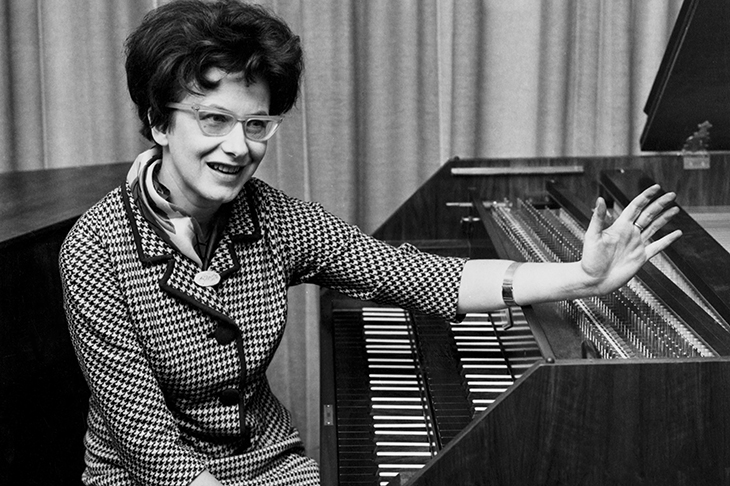One of the great joys of the 18th-century novella La petite maison is the way Jean-François de Bastide matches the proportions and shape of the book to the architecture of the exquisite country house at the story’s heart. Zuzana Ružicková, the outstanding Czech harpsichordist who died in 2017 while working with Wendy Holden on this touching memoir, analyses Bach, a composer she more or less made her own in the second half of the 20th century, in very similar terms:
I have a tectonic rather than a visual memory, and as the melodies begin to build, in my mind I imagine a building… I instinctively know how it is built. I understand the architecture and where it is heading — the corridors leading to rooms; stairs leading to upper levels, and ultimately to a final melody that completes the structure perfectly.
It is a lovely description. And it is no exaggeration: her performances were always beautifully structured — the corridors, stairs, and rooms all perfectly delineated, making Ružicková a most inspiring guide. One of the miracles she refers to in her book’s title is that she could do all this with hands badly damaged on her tortuous progression from the ghetto at Terezín to the camp at Auschwitz, and then Bergen-Belsen, from where British soldiers liberated her in April 1945.
Another is that she survived the camps at all — and before them the sanctions and privations, the curfews and violence, the ban on Jews owning radios or using public transport or swimming anywhere other than in the ‘Jewish lake’. She almost didn’t: the Normandy landings of 6 June 1944 threw the Germans into a panic, and gassings scheduled for Auschwitz that day — to include Ružicková, she was quite certain — were cancelled so that healthy prisoners could undertake forced labour and perhaps stave off the Allied advance.
It is miraculous too that Ružicková could carve out such a distinguished career from behind the Iron Curtain following Czechoslovakia’s annexation as an eastern bloc country after three desperately short years of liberation. Artists were now expected to serve the state and its oppressive ideology. ‘I was always too busy for communism,’ she says of her life in the early years of Soviet rule, with all the predictable repercussions such an attitude then initiated. Yet as her reputation spread beyond the eastern bloc — beyond the Czech factories and Romanian music clubs in which she was made to play, before or after weightlifters, contortionists, clowns and puppy trainers — the authorities realised the propaganda value of such a phenomenal musician and used her accordingly, holding on to the lion’s share of her foreign fees, of course.
The state-owned company Supraphon did its bit in this regard, with Ružicková recording on harpsichord all of Bach’s keyboard works (the first person to do so). The discs today sound fresh and inventive, full of tasteful registration and exquisite phrasing. Her musicality and love of Bach provoke ready comparisons with Wanda Landowska, another great Jewish musician to survive the Nazi occupation of her homeland, though only by fleeing to America a matter of days before Rommel crossed the Seine.
It seems so improbable that these two musicians avoided the fate of so many brilliant artists, thereafter changing the way we think about Bach’s music and the harpsichord. ‘Bach’s music is order in chaos,’ Ružicková writes. ‘It is beauty in ugliness.’ It is also the music she keeps in her head during the worst of her travails. ‘It didn’t weigh anything and the Nazis didn’t even know it was there.’
This is a surprisingly cohesive book, given that it began life as a series of transcripts. In her introduction Holden writes that Ružicková never refused an interview request, especially as her fame increased and when, after the collapse of communism in 1989, she was able to play and speak more freely throughout Europe.
The prose is plain and the structure non-linear — a chapter on Terezín in 1942 is followed by one on Munich in 1956, the year and place in which Ružicková’s career was effectively launched — yet this format works surprisingly well, emphasising as it does the picaresque nature of this remarkable life. Although many of these episodes were all too common, Ružicková’s singular brilliance ensured that this could be no one else’s story.
There is a hint of survivor’s guilt in the telling: Ružicková breaks her mother out of hospital after Belsen’s liberation; she changes her own medical notes and advises the doctor on various treatments; she practises beyond the pain threshold when relearning how to play the piano. Such retrospection, rendered in the present tense, lends an element of derring-do to an already scarcely believable story. Yet she survived the century’s greatest crime and went on to give us an unrivalled body of work; she can be forgiven these few quirks.






Comments